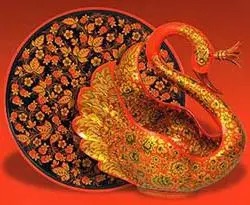Russian Folk Art
- Emilie Collings
- May 23, 2024
- 2 min read
Updated: May 28, 2024

Russian folk art is rich in symbolism, with various symbols conveying cultural, religious, and traditional meanings. Among the most popular motifs are Matryoshka dolls, which symbolize fertility, motherhood, and family. Each nested doll represents different generations or stages of life.
Khokhloma patterns, often seen in traditional Russian painting, feature vibrant red and gold floral motifs that symbolize prosperity, joy, and the beauty of nature.
Zhostovo trays are adorned with colourful and elaborate flower designs, representing beauty, nature, and the cycle of life.
Gzhel ceramics are characterized by blue and white designs featuring floral and geometric motifs, with the colour blue symbolizing the sky and spirituality.
The mythical firebird, a frequent figure in fairy tales and folklore, symbolizes beauty, grace, and the magical realm.
The sun, depicted with radiant rays, represents life, warmth, and fertility.
The rooster, a common feature in traditional wooden carvings and paintings, is a symbol of protection against evil spirits.
Swans, symbolizing love, purity, and beauty, are often featured in traditional embroidery and painting.
These symbols are deeply rooted in Russian culture and tradition, with meanings that can vary based on regional differences and personal interpretations.
COLOUR
Russian folk art is renowned for its vibrant and rich colour palette, featuring a variety of symbolic hues.
Red is a dominant colour, symbolizing beauty, love, joy, and prosperity, and is prevalent in traditional costumes, painted wooden objects, and decorative elements. Blue, often seen in deep and vibrant shades, symbolizes the sky, spirituality, and the infinite, and is frequently paired with white in intricate patterns. Gold and yellow represent wealth, prosperity, and the sun, highlighting details in paintings, carvings, and embroidery. Green signifies nature, fertility, and Russia's lush landscapes, often appearing in floral designs and landscapes.
White, symbolizing purity, innocence, and winter snow, is typically used as a background colour or in combination with other colours to create contrast. Black is employed to outline and define shapes, adding depth and contrast to the colourful designs. Brown, particularly in earthy tones, represents natural elements and is commonly used in woodwork and carvings depicting rural life. Orange adds warmth and vibrancy to certain elements, frequently appearing in floral patterns and details.
In addition to being aesthetically pleasing, these colours have cultural and symbolic meaning in Russian customs and mythology. The use of these colours in painting, needlework, and ornamental crafts, among other artistic mediums, adds to the colourful and unique style of Russian folk art.
My Artworks
These are some of my Russian style artworks I did whilst researching and narrowing down the subject that I was looking at. I loved the Russian dolls so much, I almost chose to focus on Russia instead on Scandinavia.




























































Comments